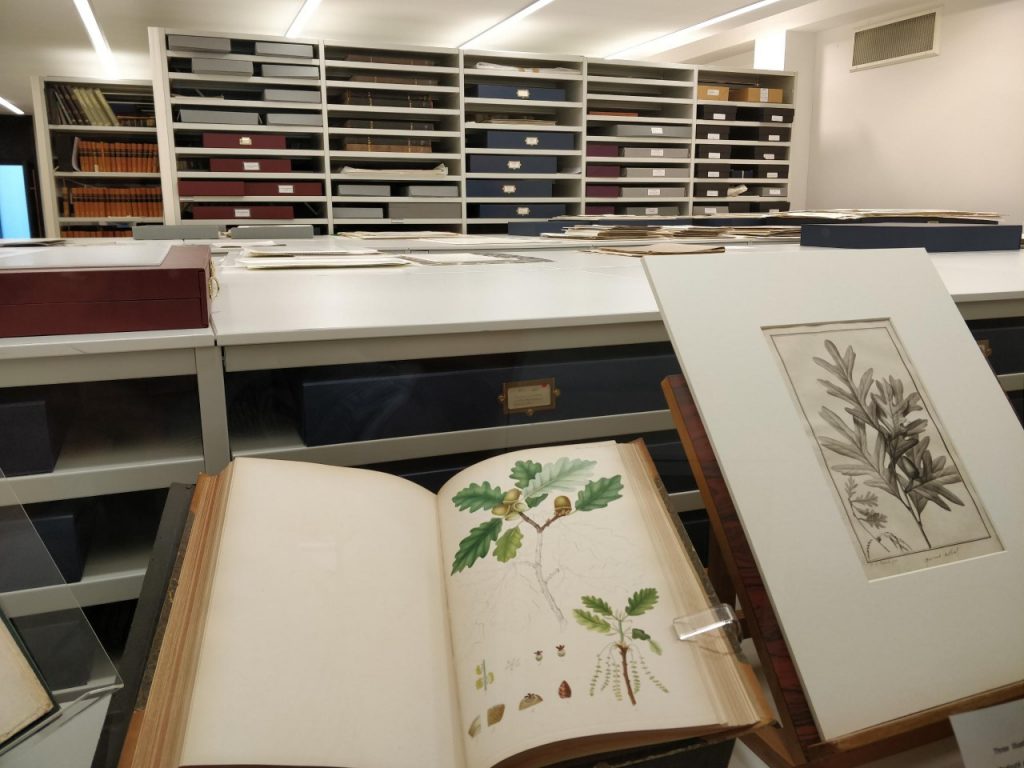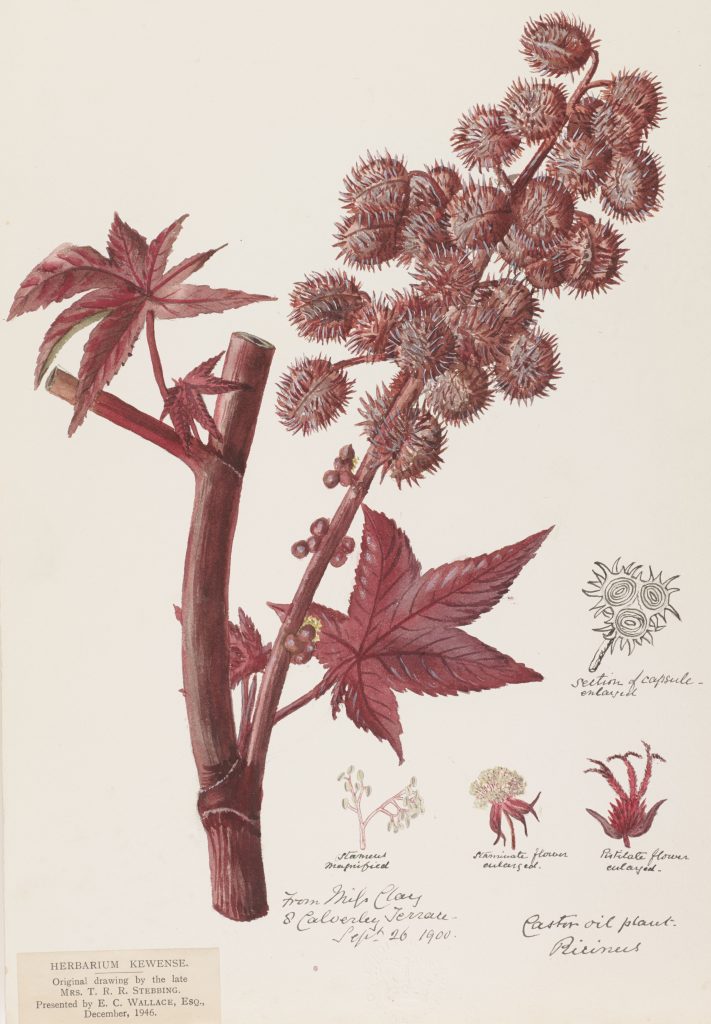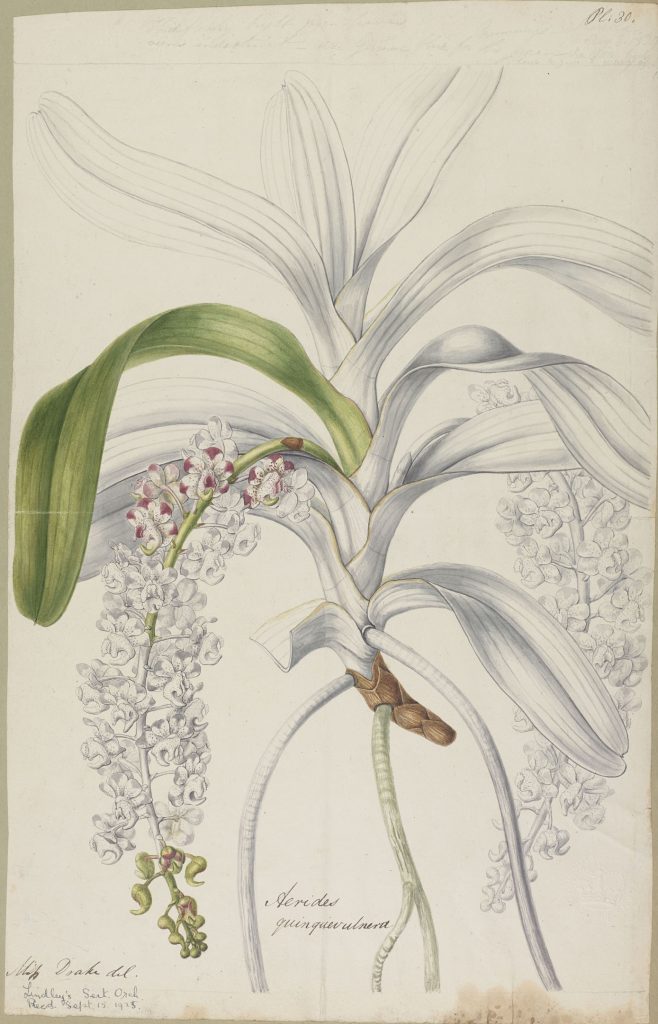Passionate pioneers – increasing access to botanical artwork by women artists
Two BHL contributors – the Royal Botanic Gardens Kew in London, UK and the Oak Spring Garden Foundation in Virginia, USA, have recently embarked on a collaborative project to digitise works of art by women botanical artists. Kew’s Metadata and Digitisation Officer Joanna Durant sheds some light on two of these often under-represented botanical pioneers.
Why Digitise?
Historically, female botanists and botanical artists were rarely given as much credit as their male counterparts. Botanical art was often viewed as a pleasant pastime for women who had time on their hands whilst their husbands were at work, and the contribution that these women made to the advancement of scientific illustration was often undermined.
To highlight the importance of these historically, scientifically and socially significant collections, Kew’s Library, Art and Archives department, in collaboration with the Oak Spring Garden Foundation, is in the process of digitising its out of copyright work by women artists, spanning several centuries.
Kew holds over 200,000 prints and drawings, and this working resource is available to staff and visitors to the department, often providing a reference tool against preserved herbarium specimens. The ultimate aim of this collaborative effort is to ensure that high quality images of illustrations and their associated data is safely stored in digital format for future generations.
The benefits of this process are threefold. We are improving access to our unique collections (the images and data will be available online), we are preventing any potential loss of information (if the worst happened and the collections were somehow lost or damaged), and we are extracting and collating artwork that is currently being stored with specimens in the herbarium. The artwork is then being rehoused in more appropriate storage conditions as the project progresses.
Think of it as a huge inventory, with photography, data transcription and then the upload of digital files to nicely wrap it all up.

One of Kew’s Library, Art and Archives temperature-controlled Stores used to house illustrations and rare books.
Botanical Pioneers
There seems to be a pattern that emerges when you start to research botanical artwork created by women, particularly those who lived and worked in the 18th, 19th and 20th centuries. “Very little is known about her…” “She published her work anonymously…” or, very commonly, was only known by her husband’s name. There are even instances of artwork not being signed or attributed to any particular artist at all.
These often-unrecognised artists made a huge impact on our current understanding of botany. From the anatomical structure of plants to the habitats in which they grew and the communities that relied on them, women botanical artists were real trailblazers in their field.
Mary Anne Stebbing and the Empty Chair
“Mrs T. R. R. Stebbing” can be found on numerous acquisition labels on illustrations in Kew’s collection. It is actually referring to the early 20th century botanical artist Mary Anne Stebbing (née Saunders), under her zoologist-husband’s name, Thomas Roscoe Rede Stebbing.
Born in around 1845 into a family of keen naturalists, Mary began gathering and sketching plants at an early age, and her ambition was to “illustrate the British flora by water-colour drawings”. Sadly, a fire in 1881 destroyed much of her early work, but her resulting later illustrations took on a more detailed and scientific feel with various anatomical sections of plants and notes on habitats and locations included.
Mary illustrated many species for her husband’s scientific publications, often branching out from botany into Crustacea. Interestingly, she was never credited for her vital contributions, and despite working in scientific collaboration with her husband, the papers were always published in his name. However, in her husband’s obituary in 1926, Nature referred to Mary as “an accomplished botanist”, inferring that by this time she was very much viewed as a botanist in her own right among her peers.
However, there is more to the story of Mary Anne Stebbing than meets the eye, and it is a fascinating glimpse into Edwardian social history.
Mary’s husband, Thomas, was a member of the Linnean Society – a prestigious society dedicated to the study of evolution and natural history and one which was, traditionally, strictly men only. Thomas felt strongly that women should also be accepted as members, and Mary was successfully invited to become one of the first female members in 1905. To mark this occasion, a painting was commissioned by the Treasurer, Frank Crisp, by the artist James Sant.
In the painting, Mary is positioned prominently in the foreground, in front of her husband. Also pictured is Catherine, Frank’s wife, who was also being admitted as a new Society member. In a telegraph from Frank after the painting was completed, his attitude towards the significance of Mary’s position within the artwork can be seen: “we must surely have at the table a lady fellow who has done something, not one without a record”. Whether the absence of Mary’s name on her and her husband’s papers was being referenced, or whether Crisp simply didn’t believe that she was worthy of scientific recognition, we may never fully understand. Press coverage of the painting was scathing – one newspaper advised not missing a glimpse of the picture as it would “make you laugh”. Crisp withheld the artwork until his death in 1919, but by that time, the painting had been altered. Both Mary and Thomas had been painted out, with Mary being replaced by an empty chair.

Watercolour of a Castor oil plant (Ricinus communis) showing various enlarged sections by Mary Anne Stebbing (c1845 – 1927). Copyright of Royal Botanic Gardens Kew.
Sarah Anne Drake
An interesting example of an artist of whom very little is known is Sarah Anne Drake (1803 – 1857), or “Miss Drake”, as she often signed her work.
Born in Norfolk, UK, Sarah Anne Drake moved to London in around 1830. Through a family friendship, she was brought into the household (possibly to act as a children’s governess) of John Lindley, the then secretary of the Horticultural Society of London and a keen botanist. John soon recognised that Sarah was an extremely talented artist, and within a few years she had been commissioned to illustrate his famous publication Sertum Orchidaceum (1837 – 1841).
The 19th century saw an explosion of interest in orchids (one might even describe it as an obsession). For the Victorians, orchids represented romance and seduction, and scientists were keen to illustrate these incredible and exotic plants to accompany their publications. Sertum Orchidaceum was indeed a lavish example of this botanical craze.

A plate for Sertum Orchidaceum entitled Aerides quinquevulnera by Sarah Anne Drake (1803 – 1857). Copyright of Royal Botanic Gardens Kew.
John Lindley, Jane Loudon and Ladies botany
Sarah Anne Drake also provided highly technical illustrations for several other publications at the time, including another written by John Lindley, the fascinatingly titled Ladies Botany (1834 – 1837).
John Lindley used this publication in his quest to make botany more “scientific” – he was one of a growing number of scientists and philosophers who became fixated with challenging botany’s reputation for being “unmanly”, “amateur” and above all, feminine. Botany was viewed as a separate discipline distinct from mainstream science, and academics such as John Lindley aimed to defeminise and modernise it. In Ladies Botany, the author attempts to displace the traditional Linnaean system of study (which was viewed as being strongly wedded to the amateur student) with a more natural system. Unfortunately, the rhetoric in the publication is gendered and, when read now, can be described as condescending.
It wasn’t until 1842 that a popular book successfully began to introduce the natural system of study, with the publication of Botany for ladies; or a popular introduction to the natural system of plants by Jane Loudon (1807 – 1858).
This book takes the reader through the botanical orders and introduces de Candolle’s systematic description of species, and opens with a frank statement from the author that as a child she could “never learn botany”. The introduction describes how books on the subject, with the exception of John Lindley’s, were “all sealed to me”, and also includes the following telling sentence: “It is so difficult for men whose knowledge has grown with their growth, and strengthened with their strength, to imagine the state of profound ignorance in which a beginner is, that even their elementary books are like the old Eton Grammar when it was written in Latin – they require a master to explain them.”
The influence of women botanists and botanical artists on the progression of botanical knowledge can be traced back for centuries, and the way that these women were viewed by the male-dominated field of science is a fascinating glimpse into an important part of our social history. It is the aim of organisations such as BHL, Oak Spring and Kew Gardens to document and disseminate the incredible achievements of these women for future generations.
Further Reading and References
Figuring it out: Science, gender and visual culture by Ann B. Shteir and Bernard Lightman
Bloom: The Botanical Vernacular in the English Novel by Amy King





Leave a Comment